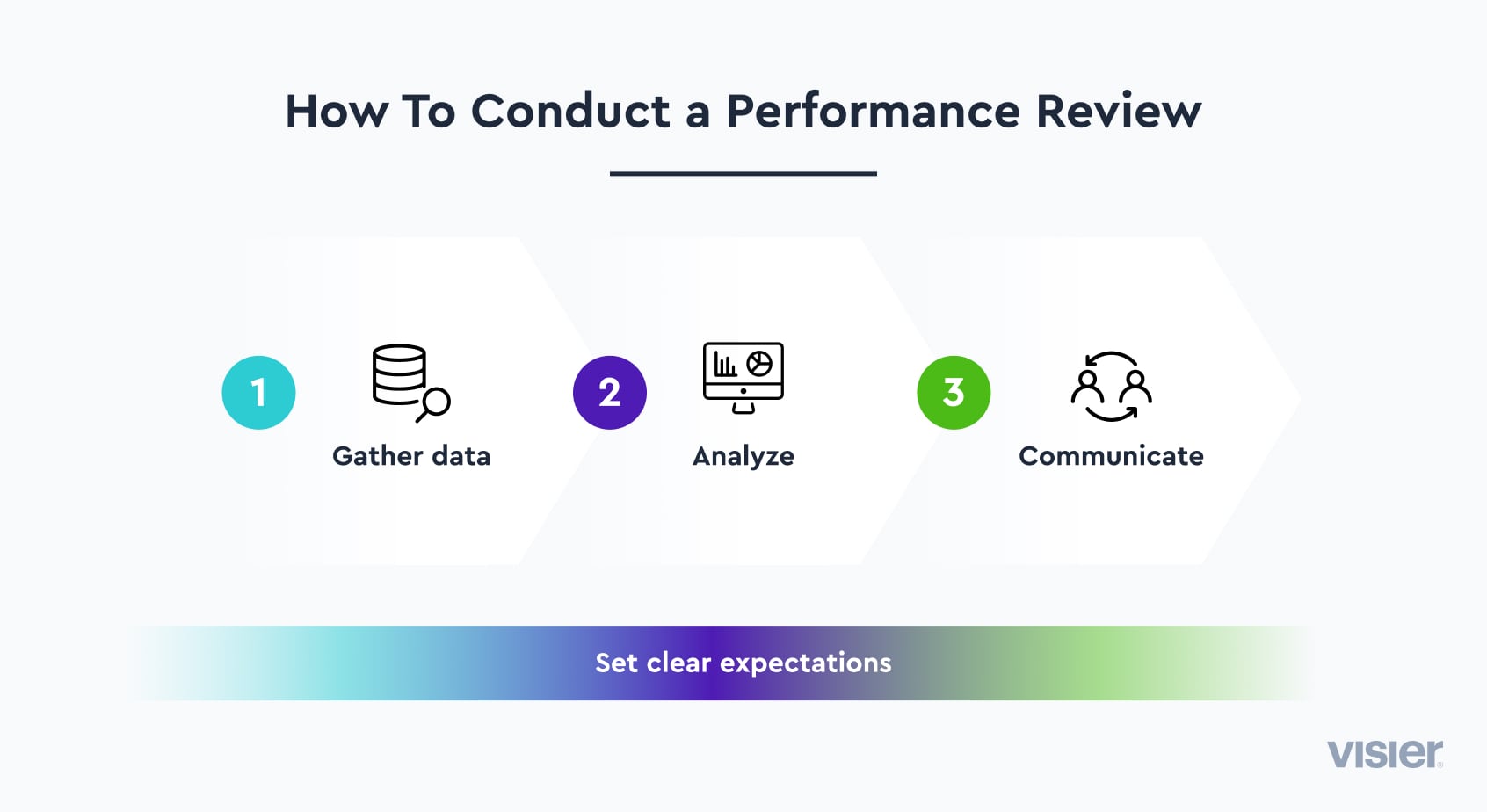MANAGER EFFECTIVENESS
What Are Performance Reviews and Why Should You Conduct Them?
Formal and informal performance reviews help managers and employees stay aligned on successes, areas of improvement, and opportunities for growth. Read this guide to learn more.
Explore compensation strategies
Table of contents
What are performance reviews?Why you should conduct a performance reviewHow to conduct a performance reviewPerformance review examples and phrases to useHow to use Visier to create better performance reviewsWhat are performance reviews?
Performance reviews are formal assessments in which managers assess an employee’s performance, acknowledge positive results, and provide guidance on areas of improvement. The goal is to identify their strengths and weaknesses and to help them improve in the future.
Also known as a performance evaluation, a performance review will, when correctly executed, boost performance and productivity.
Types of performance reviews
Performance reviews vary depending on the frequency with which you conduct them. The main types of performance reviews are:
Weekly or fortnightly reviews work with a small amount of data. They don’t look at the overall performance. Instead, they assess the work done for a project or other small tasks.
Monthly employee reviews are useful for businesses that employ people short term or work with freelancers. You can also use them to assess the performance immediately after the onboarding process to check how someone goes from the job description to actual work.
Quarterly performance reviews are useful if your company divides business goals and activities into quarters. If all your budget, projects, and targets are set quarterly, it makes sense to evaluate performance in the same way. You can add weekly or monthly evaluations for short-term employees or to gauge performance for a certain project.
Annual reviews used to be the most popular type but are slowly being replaced by quarterly reviews or other surveys throughout the year. Annual reviews can offer a great view of an employee’s performance. However, they often contain a lot of data that can take time to interpret.
Each type of performance review has its merit, depending on the circumstances under which it’s delivered. The goal for managers should be to always be providing honest feedback to their employees, and conducting formal assessments as required by company policy.
What should you include in a performance review?
What a performance review looks like depends a lot on the position you’re evaluating, your industry, and your company’s goals. There are, however, a few things that most evaluations should look at:
Problem-solving abilities
How the employee collaborates with their teammates
Reliability and punctuality
Quality of work
How well the employee meets goals and deadlines
Communication
Don’t forget to look at the person’s accomplishments. Perhaps they learned a new skill or exceeded their goals. A skill analysis is also useful, though many omit it from their performance reviews.
Once you finish your review, give the employee feedback. Be sure your opinion is honest. If you must criticize, do so in a constructive manner. Give examples of what went wrong and help them understand how they can improve.

Why you should conduct a performance review
Performance reviews offer several benefits for employees, managers, and the organization. They allow you to evaluate the strengths and weaknesses of employees. They’re also an opportunity to review business goals and make sure everyone is aligned with them.
Here are some of the most significant benefits of conducting performance reviews.
They pave the way for career development. By outlining strengths and weaknesses, performance reviews can show your employees how to further grow in their roles. Some may benefit from upskilling, while others may be the perfect candidates for reskilling. Whatever the conclusion, a periodic performance review can show you various opportunities for improvement.
Regular feedback improves performance. When employees know they’re doing a good job and that their efforts are recognized, they’re more likely to keep working harder. Similarly, someone who hasn’t performed their best can improve once they understand what they did wrong, or where they can improve.
Help everyone understand the business goals. Individual performance contributes to business performance. When everyone understands what the company’s goals are and works towards them, productivity and performance improve significantly.
Regular performance reviews allow you to create effective merit increase programs. A merit increase program can boost engagement, satisfaction, productivity, and performance. Conducting regular performance reviews allows you to create a fair and transparent merit increase program.
How to conduct a performance review
The steps you take toward a performance evaluation will vary depending on the type of review. A weekly assessment, for instance, will look at different things than a quarterly one. That’s because the weekly review will usually focus on a single task, whereas the quarterly one will look at overall performance and goal attainment over a three-month time span.
A quarterly review, on the other hand, will need to look at various tasks, plus the interaction with peers, and more. Regardless of the type of review you’re running, there are a few things you need to keep in mind.
1. Gather data
Before you conduct a performance review, you need to first prepare. Make sure you have all the data you need about your employees. Don’t gather more information than necessary, as it will make the process ineffective.
For instance, start by focusing on their work performance.
What projects did they work on since the last performance review?
What were the results?
Did they meet expectations?
Did they exceed expectations?
Next, you might want to look at their work ethic and their interaction with teammates.
Did they miss work a lot?
Were they always on time?
Did they meet deadlines?
How do they collaborate with others?
Keep in mind that the questions you ask can vary from role to role. There are cases when communication and interaction with others on the team can be crucial. In other cases, the task might require little to no interaction with peers. Adjust your evaluation system accordingly.
2. Analyze the previous performance reports
Before you begin your new report, it’s essential to look at the previous ones. This will help you see how and if a person is improving, or, on the contrary, if they’re performing worse.
It will also show you if the employee is using the feedback they receive. That way, you’ll know how to adjust your current review. And you’ll be able to see issues with your own evaluation.
For instance, if you find that one employee didn’t incorporate any of the feedback to improve their performance, the issue may be with them. But if you find this is a general problem with most employees, you might want to look at how you offer feedback. Are you constructive? Did they understand where and how they can improve? How can the current report be better?
If you do find that your feedback is not being received and actioned, you can try incorporating some simple communications techniques into your performance review sections.
Ask your employee if they can rehash the key takeaways and action items from the conversation, or if anything was unclear. If they can’t, or they’re unsure about a key takeaway, try communicating it differently.
Often, a simple rephrasing of a suggestion will help set the employee on the right path.

3. Ask for feedback
Performance reviews shouldn’t be a monologue where you deliver your thoughts and the others just listen.
Ask for their feedback. What do they think about your review? How do they feel about their work in general? Are there any problems they’d want to discuss?
Being open and creating a space where people feel safe expressing their thoughts and discussing their problems will help boost engagement and satisfaction, and will help the company grow.
4. Make your expectations clear
Performance reviews shouldn’t be wrapped in mystery. Their goal is to improve results, productivity, and performance, not to scare employees.
Before and during your review, make sure employees know what to expect.
What can earn them a merit increase?
What’s the optimal performance you’re expecting?
If they didn’t meet expectations, what’s next?
How can they improve?
Again, clear and two-way communication is the goal in any performance review. Both parties should walk away feeling that they were heard, and that they understand what is expected of them next.
Ideally, the feedback you give to employees in a performance review should never come as a surprise. While performance reviews may be a formal event, feedback should be a regular and ongoing occurrence. If there is a big disconnect between how you review your employee, and what they think of their own performance, then this may indicate an issue with your overall feedback policy.

Performance review examples and phrases to use
How your performance review will look depends on what you want to focus on, the business goals, and other particularities of the employee’s position.
You can divide your review based on different categories. For instance, a report looking at leadership qualities could say things like:
Holding team members accountable;
Communicating well with team members and taking their ideas and feedback into consideration;
Helping members of the team with work-related problems.
Talking about their capacity to accomplish goals could include phrases such as:
Achieving objectives and goals;
Setting their challenges and goals;
Always having a clear view of company goals;
Being persistent when facing problems and working hard to overcome obstacles.
You can also choose to write a general review instead of dividing it. Here’s an example of a review for a UX designer that includes constructive criticism.
John meets company expectations in his role as a UX designer. He adapts to each project’s requirements and always delivers projects on time. He works well under pressure and collaborates well with his teammates.
While he has great potential, John doesn’t actively seek to improve his skills and hasn’t participated in any upskilling training over the past year. Such training could be beneficial for him and might even make him a candidate for a leadership position in the future.
As you can see from these examples, the emphasis should be on the things employees are doing well. When discussing things that could use some improvements, include an explanation. Let them know why you think that is important and what the benefits could be if they improved in that area.

How to use Visier to create better performance reviews
Performance reviews are a useful but sometimes challenging process. You need to be fair and transparent and offer constructive feedback that helps both the employees and the business grow.
For that, the first step is to analyze the data correctly and objectively. People analytics can help you gather the data and view the results that matter. Getting an optimal view of all the information can be challenging, especially when running quarterly or yearly reports.
A tool like Visier People can take some of the pressure off of your shoulders. Check the metrics that count to make fair and transparent decisions that will help your employees improve constantly.
Reviewing managerial performance is another critical step. Managers can have a huge impact on people. They can motivate them and drive them toward success. Or they can drag them down and break the team apart.
See managers’ impact on people
Visier allows you to assess the manager’s impact on people. It looks at multiple dimensions such as retention, engagement, or productivity, and helps you identify top performers and areas that could be improved.
We talked about merit increases to reward high performers. These are part of a strategic compensation plan that can help boost productivity and employee satisfaction. But creating such a program can be sometimes challenging.
You need to pay equitably and allocate merit rewards when they’re due. Visier’s Strategic Compensation can help you do just that, all while making sure you’re allocating the budget so that merit increases will have a positive impact on your business.
![The Manager's Ultimate Guide to Making Equitable Merit Pay Decisions [CARD ASSET]](https://images.ctfassets.net/lbgy40h4xfb7/3wOsNyYipV9dGpty59GQ0B/ffdac1d944b5bb8f942b3b0fde69e830/managers-guide-equitable-pay-card.jpg?w=1200&h=700&fl=progressive&q=100&fm=jpg)
![The Last Mile Problem [CARD ASSET]](https://images.ctfassets.net/lbgy40h4xfb7/59jD1cBcKafbv6ZAOaBHF9/f03062c405593f70a2aa6d94cd772ff8/last-mile-problem-resource-card.jpg?w=1200&h=700&fl=progressive&q=100&fm=jpg)
